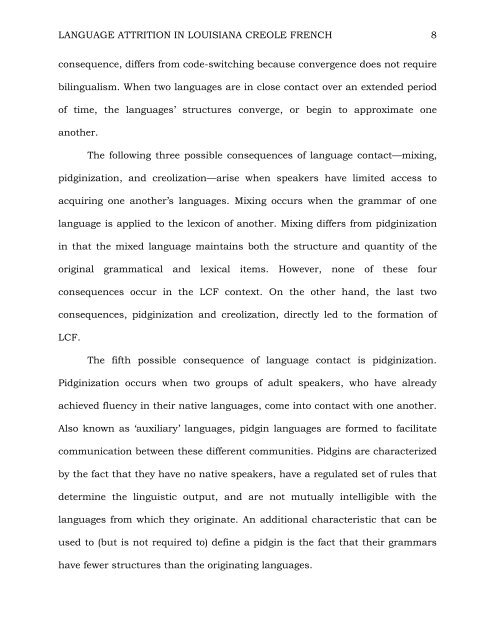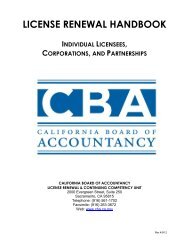Language Attrition in Louisiana Creole French
Language Attrition in Louisiana Creole French
Language Attrition in Louisiana Creole French
You also want an ePaper? Increase the reach of your titles
YUMPU automatically turns print PDFs into web optimized ePapers that Google loves.
LANGUAGE ATTRITION IN LOUISIANA CREOLE FRENCH 8<br />
consequence, differs from code-switch<strong>in</strong>g because convergence does not require<br />
bil<strong>in</strong>gualism. When two languages are <strong>in</strong> close contact over an extended period<br />
of time, the languages‟ structures converge, or beg<strong>in</strong> to approximate one<br />
another.<br />
The follow<strong>in</strong>g three possible consequences of language contact—mix<strong>in</strong>g,<br />
pidg<strong>in</strong>ization, and creolization—arise when speakers have limited access to<br />
acquir<strong>in</strong>g one another‟s languages. Mix<strong>in</strong>g occurs when the grammar of one<br />
language is applied to the lexicon of another. Mix<strong>in</strong>g differs from pidg<strong>in</strong>ization<br />
<strong>in</strong> that the mixed language ma<strong>in</strong>ta<strong>in</strong>s both the structure and quantity of the<br />
orig<strong>in</strong>al grammatical and lexical items. However, none of these four<br />
consequences occur <strong>in</strong> the LCF context. On the other hand, the last two<br />
consequences, pidg<strong>in</strong>ization and creolization, directly led to the formation of<br />
LCF.<br />
The fifth possible consequence of language contact is pidg<strong>in</strong>ization.<br />
Pidg<strong>in</strong>ization occurs when two groups of adult speakers, who have already<br />
achieved fluency <strong>in</strong> their native languages, come <strong>in</strong>to contact with one another.<br />
Also known as „auxiliary‟ languages, pidg<strong>in</strong> languages are formed to facilitate<br />
communication between these different communities. Pidg<strong>in</strong>s are characterized<br />
by the fact that they have no native speakers, have a regulated set of rules that<br />
determ<strong>in</strong>e the l<strong>in</strong>guistic output, and are not mutually <strong>in</strong>telligible with the<br />
languages from which they orig<strong>in</strong>ate. An additional characteristic that can be<br />
used to (but is not required to) def<strong>in</strong>e a pidg<strong>in</strong> is the fact that their grammars<br />
have fewer structures than the orig<strong>in</strong>at<strong>in</strong>g languages.
















